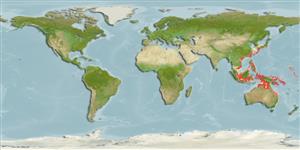Teleostei (teleosts) >
Gobiiformes (Gobies) >
Gobiidae (Gobies) > Gobiinae
Etymology: papilio: Name from Latin 'papilio' meaning butterfly, used as the generic name of the swallowtail butterfly, refers to the elongate, filamentous fifth and ninth branched caudal-fin rays (like the 'tails' of the swallowtail butterfly); noun in apposition.
Eponymy: Professor Cornelius Jan van der Horst (1889–1951) was a Dutch zoologist who moved to South Africa (1928) and became Head of the Zoology Department, Witwatersrand University, Johannesburg. [...] (Ref. 128868), visit book page.
Environment: milieu / climate zone / depth range / distribution range
Ecology
Marine; demersal; depth range 5 - 55 m (Ref. 90102). Temperate
Northwest Pacific: Ryukyu Is., Japan.
Size / Weight / Age
Maturity: Lm ? range ? - ? cm
Max length : 4.1 cm SL male/unsexed; (Ref. 55718)
Short description
Identification keys | Morphology | Morphometrics
Dorsal spines (total): 7; Dorsal soft rays (total): 11; Anal spines: 1; Anal soft rays: 11; Vertebrae: 26. This species is distinguished from its congeners in having the following set of characters: segmented dorsal-fin rays 11; segmented anal-fin rays 11; longitudinal scales 27; predorsal scales 11; third spine of first dorsal fin elongate, filamentous, and longer than the other spines; fifth and ninth branched caudal-fin rays elongate, filamentous, and forming bifurcate caudal fin; fifth and ninth branched rays each with a single branch; cephalic sensory-papillae row 'a' with 3 widely spaced papillae; numerous small yellow spots scattered on cheek, operculum, nape, body, and dorsal fins in fresh or live individuals; below the eye is a dusky yellowish brown vertical bar; body with 4 dark gray brown saddles, in addition to a similarly colored large blotch at midlateral caudal-fin base (Ref. 55718).
Body shape (shape guide): elongated.
A single specimen collected from a sandy-mud bottom at a depth of 45 m in a protected bay. Observed to be usually at 40-50 m depths (area with pebbles); the young at depths of 8 m to about 30 m, but apparently on rare occasions; the species symbiotically associates with alpheid shrimp (species name uncertain) (Ref. 55718).
Life cycle and mating behavior
Maturity | Reproduction | Spawning | Eggs | Fecundity | Larvae
Shibukawa, K. and T. Suzuki, 2004. Vanderhorstia papilio, a new shrimp-associated goby from the Ryukyu Islands, Japan (Perciformes: Gobiidae: Gobiinae), with comments on the limits of the genus. Ichthyol. Res. 51:113-119. (Ref. 55718)
IUCN Red List Status (Ref. 130435: Version 2025-1)
Threat to humans
Harmless
Human uses
Tools
Special reports
Download XML
Internet sources
Estimates based on models
Preferred temperature (Ref.
123201): 23.6 - 28.9, mean 27.9 °C (based on 202 cells).
Phylogenetic diversity index (Ref.
82804): PD
50 = 0.5000 [Uniqueness, from 0.5 = low to 2.0 = high].
Bayesian length-weight: a=0.00724 (0.00339 - 0.01546), b=3.10 (2.92 - 3.28), in cm total length, based on LWR estimates for this (Sub)family-body shape (Ref.
93245).
Trophic level (Ref.
69278): 3.2 ±0.3 se; based on size and trophs of closest relatives
Resilience (Ref.
120179): High, minimum population doubling time less than 15 months (Preliminary K or Fecundity.).
Fishing Vulnerability (Ref.
59153): Low vulnerability (10 of 100).
🛈
